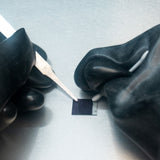How to Fabricate Perovskite Solar Cells
Instructions for how to fabricating perovskite solar cells with the following architecture: SNO2/perovskite materials/Spiro-OMeTAD (sublimed)/Au Solar Devices:
Perovskite Materials

Resources and Support
 PTAA or Spiro-OMeTAD? | Choosing a HTL for your Solar Cells
PTAA or Spiro-OMeTAD? | Choosing a HTL for your Solar Cells
Poly[bis(4-phenyl)(2,4,6-trimethylphenyl)amine] (PTAA) and 20,7,70-tetrakis[N,N-di(4-methoxyphenyl)amino]-9,90-spirobifluorene (Spiro-OMeTAD) are both used as hole transport layers in high efficiency perovskite solar cells (PSCs). Regular architecture devices using PTAA and Spiro-OMeTAD layers have demonstrated power conversion efficiencies (PCEs) of over 22% and 25% respectively. Additionally, inverted p-i-n devices using PTAA have achieved PCE exceeding 25%.
Read more... How to Make Efficient Perovskite Solar Cells in a Glove Box
How to Make Efficient Perovskite Solar Cells in a Glove Box
This video details how to make highly efficient perovskite solar cells using the Ossila I301 ink with the following device stack: ITO-coated glass / SnO2 / I301 / Spiro-OMeTAD / Au. Various other perovksites and transport materials, along with references and examples of their uses, can be found on our "Ultimate Guide to Perovskites" page - but we thought it would be useful to demonstrate an example of how to make a PSC (that can acheive over 19% PCE), from start to finish. We've also tried to include some helpful tips to perfect your technique.
Read more...